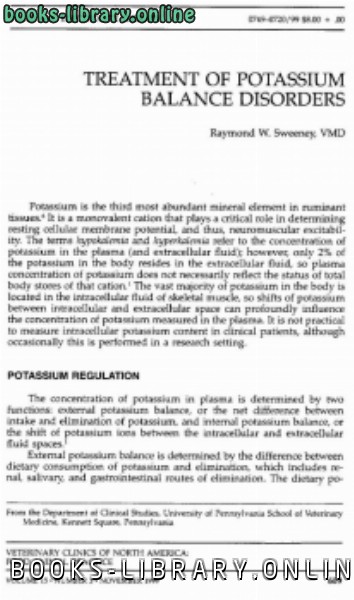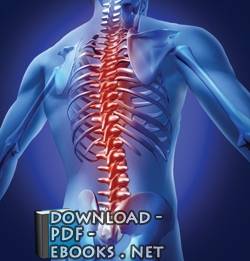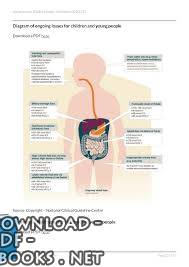كتاب 2. Treatment of potassium balance disorders
2. Treatment of potassium balance disorders من كتب طب بيطرى s. Potassium Balance Disorders Potassium is the primary intracellular electrolyte, and because of its positive charge it is considered the primary intracellular cation. The total amount of potassium in the body is related to the person's size, but it averages 3,200 mEq in males and 2,200 in females. Of the body's potassium, 70% is found in skeletal muscle, and 28% is found in the liver and red blood cells, which means that 98% of the potassium in the body is in the intracellular fluid. The remaining 2% is found in the extracellular fluid. It is this 2% that is critical to normal cardiovascular and neuromuscular function, and it is what is measured in a serum potassium reading. The normal serum potassium is 3.5 to 5.0 mEq/L. Having too little potassium (less than 3.5 mEq/L) is called hypokalemia, while having too much (more than 5.5 mEq/L) is called hyperkalemia. Even minor variations in serum potassium levels can have significant impact on cardiovascular and neuromuscular function. This is because the ratio of intracellular to extracellular potassium is an important determinant of cellular membrane potential. Potassium is constantly moving between the ICF and ECF by way of the sodium-potassium pump. Adequate renal function is necessary to maintain normal potassium levels. There are two methods by which the kidneys regulate potassium balance. First, potassium and hydrogen ions compete for exchange with sodium ions in the renal tubules. The urine salt content is adjusted by the distal convoluted tubules of the kidney. Second, aldosterone causes the kidneys to retain sodium, which in turn causes retention of water. To retain sodium, the kidneys excrete potassium. Nine-tenths of the potassium excreted daily is excreted in the urine, while the other 10% is lost through the feces and sweat glands. Because the body cannot store potassium, it must be ingested daily—the body needs 40 mEq a day. The normal diet contains 60 to 100 mEq a day, and the potassium balance is maintained by a daily intake and output of 50 to 100 mEq.Raymond W.Sweeney - ❰ له مجموعة من الإنجازات والمؤلفات أبرزها ❞ 2. Treatment of potassium balance disorders ❝ ❱
من كتب الطب البشري - مكتبة كتب الطب.

قراءة كتاب 2. Treatment of potassium balance disorders أونلاين
معلومات عن كتاب 2. Treatment of potassium balance disorders:
s.
Potassium Balance Disorders
Potassium is the primary intracellular electrolyte, and because of its positive charge it is considered the primary intracellular cation. The total amount of potassium in the body is related to the person's size, but it averages 3,200 mEq in males and 2,200 in females. Of the body's potassium, 70% is found in skeletal muscle, and 28% is found in the liver and red blood cells, which means that 98% of the potassium in the body is in the intracellular fluid. The remaining 2% is found in the extracellular fluid. It is this 2% that is critical to normal cardiovascular and neuromuscular function, and it is what is measured in a serum potassium reading.
The normal serum potassium is 3.5 to 5.0 mEq/L. Having too little potassium (less than 3.5 mEq/L) is called hypokalemia, while having too much (more than 5.5 mEq/L) is called hyperkalemia. Even minor variations in serum potassium levels can have significant impact on cardiovascular and neuromuscular function. This is because the ratio of intracellular to extracellular potassium is an important determinant of cellular membrane potential. Potassium is constantly moving between the ICF and ECF by way of the sodium-potassium pump.
Adequate renal function is necessary to maintain normal potassium levels. There are two methods by which the kidneys regulate potassium balance. First, potassium and hydrogen ions compete for exchange with sodium ions in the renal tubules. The urine salt content is adjusted by the distal convoluted tubules of the kidney. Second, aldosterone causes the kidneys to retain sodium, which in turn causes retention of water. To retain sodium, the kidneys excrete potassium. Nine-tenths of the potassium excreted daily is excreted in the urine, while the other 10% is lost through the feces and sweat glands. Because the body cannot store potassium, it must be ingested daily—the body needs 40 mEq a day. The normal diet contains 60 to 100 mEq a day, and the potassium balance is maintained by a daily intake and output of 50 to 100 mEq.
سنة النشر : 2000م / 1421هـ .
عدد مرات التحميل : 14006 مرّة / مرات.
تم اضافته في : السبت , 26 مارس 2016م.
حجم الكتاب عند التحميل : 1.6 ميجا بايت .
تعليقات ومناقشات حول الكتاب:
2. Treatment of potassium balance disorders من كتب طب بيطرى
s.
Potassium Balance Disorders
Potassium is the primary intracellular electrolyte, and because of its positive charge it is considered the primary intracellular cation. The total amount of potassium in the body is related to the person's size, but it averages 3,200 mEq in males and 2,200 in females. Of the body's potassium, 70% is found in skeletal muscle, and 28% is found in the liver and red blood cells, which means that 98% of the potassium in the body is in the intracellular fluid. The remaining 2% is found in the extracellular fluid. It is this 2% that is critical to normal cardiovascular and neuromuscular function, and it is what is measured in a serum potassium reading.
The normal serum potassium is 3.5 to 5.0 mEq/L. Having too little potassium (less than 3.5 mEq/L) is called hypokalemia, while having too much (more than 5.5 mEq/L) is called hyperkalemia. Even minor variations in serum potassium levels can have significant impact on cardiovascular and neuromuscular function. This is because the ratio of intracellular to extracellular potassium is an important determinant of cellular membrane potential. Potassium is constantly moving between the ICF and ECF by way of the sodium-potassium pump.
Adequate renal function is necessary to maintain normal potassium levels. There are two methods by which the kidneys regulate potassium balance. First, potassium and hydrogen ions compete for exchange with sodium ions in the renal tubules. The urine salt content is adjusted by the distal convoluted tubules of the kidney. Second, aldosterone causes the kidneys to retain sodium, which in turn causes retention of water. To retain sodium, the kidneys excrete potassium. Nine-tenths of the potassium excreted daily is excreted in the urine, while the other 10% is lost through the feces and sweat glands. Because the body cannot store potassium, it must be ingested daily—the body needs 40 mEq a day. The normal diet contains 60 to 100 mEq a day, and the potassium balance is maintained by a daily intake and output of 50 to 100 mEq.
 مهلاً !
مهلاً !قبل تحميل الكتاب .. يجب ان يتوفر لديكم برنامج تشغيل وقراءة ملفات pdf
يمكن تحميلة من هنا 'تحميل البرنامج'

نوع الكتاب : pdf.
اذا اعجبك الكتاب فضلاً اضغط على أعجبني و يمكنك تحميله من هنا:


كتب اخرى في كتب الطب البشري

Laboratory Exercises Microbiology ( second edition) PDF
قراءة و تحميل كتاب Laboratory Exercises Microbiology ( second edition) PDF مجانا








